MOG 7 Assignment: Ford and Taylorism, Globalization Theories
VerifiedAdded on 2020/03/02
|8
|1702
|449
Homework Assignment
AI Summary
This MOG assignment examines the principles of Ford and Taylorism, highlighting their focus on efficiency and speed through task breakdown and repetition, and their continued relevance in modern contexts such as employee induction. The assignment then explores Thomas Friedman's views on globalization, including his three eras and the concept of a 'flat world,' emphasizing the need for global collaboration, connection, and competition, as well as the importance of risk-taking and a global mindset. It also delves into Pankaj Ghemawat's contrasting perspective, arguing that the world is less globalized than commonly believed due to inaccuracies in trade, immigration, and investment data. The assignment analyzes these conflicting viewpoints and their implications for global welfare, including the impact of globalization on individuals, companies, and countries, and the challenges and opportunities of operating in an interconnected world. The assignment references various sources including videos and academic papers, to support the arguments and provide a comprehensive analysis of the subject.
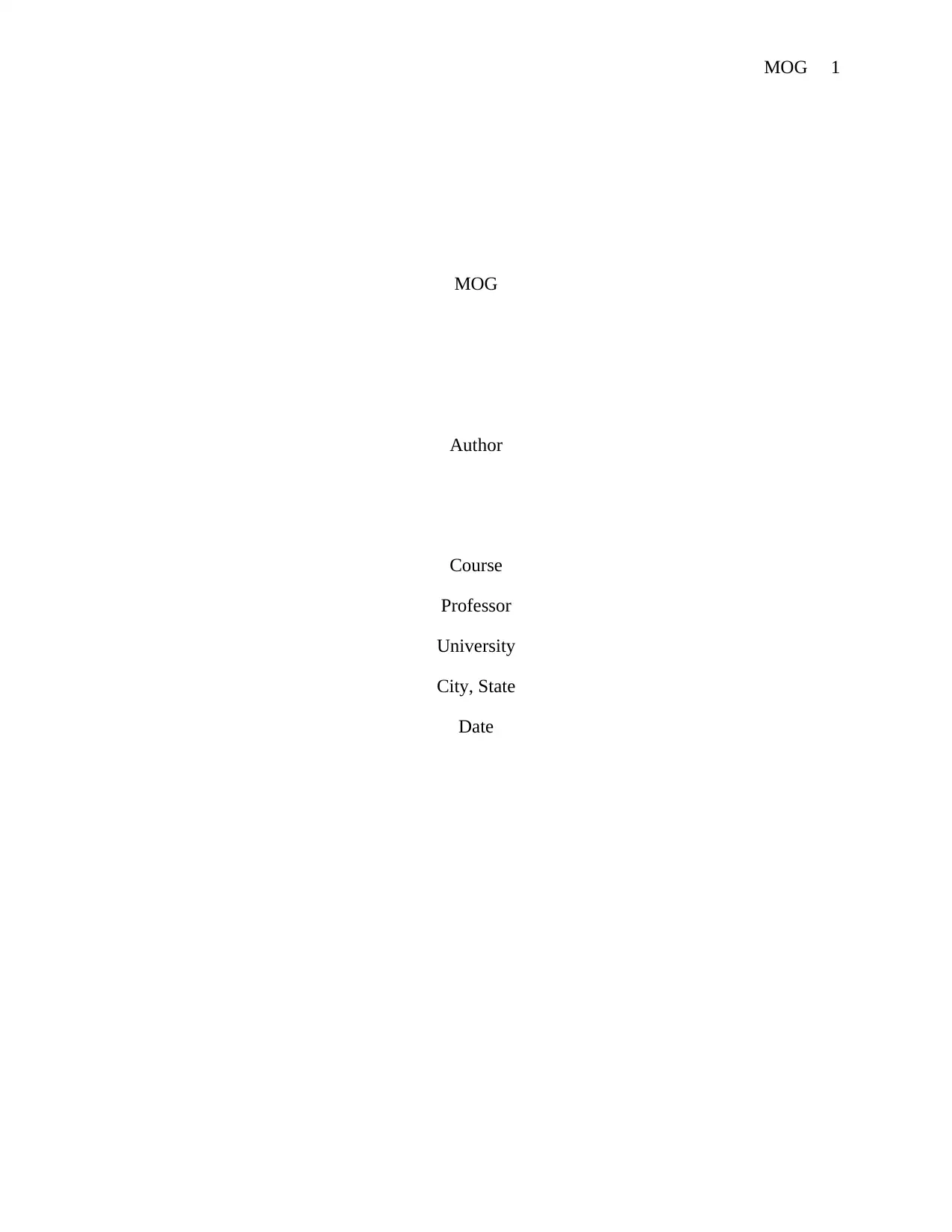
MOG 1
MOG
Author
Course
Professor
University
City, State
Date
MOG
Author
Course
Professor
University
City, State
Date
Paraphrase This Document
Need a fresh take? Get an instant paraphrase of this document with our AI Paraphraser
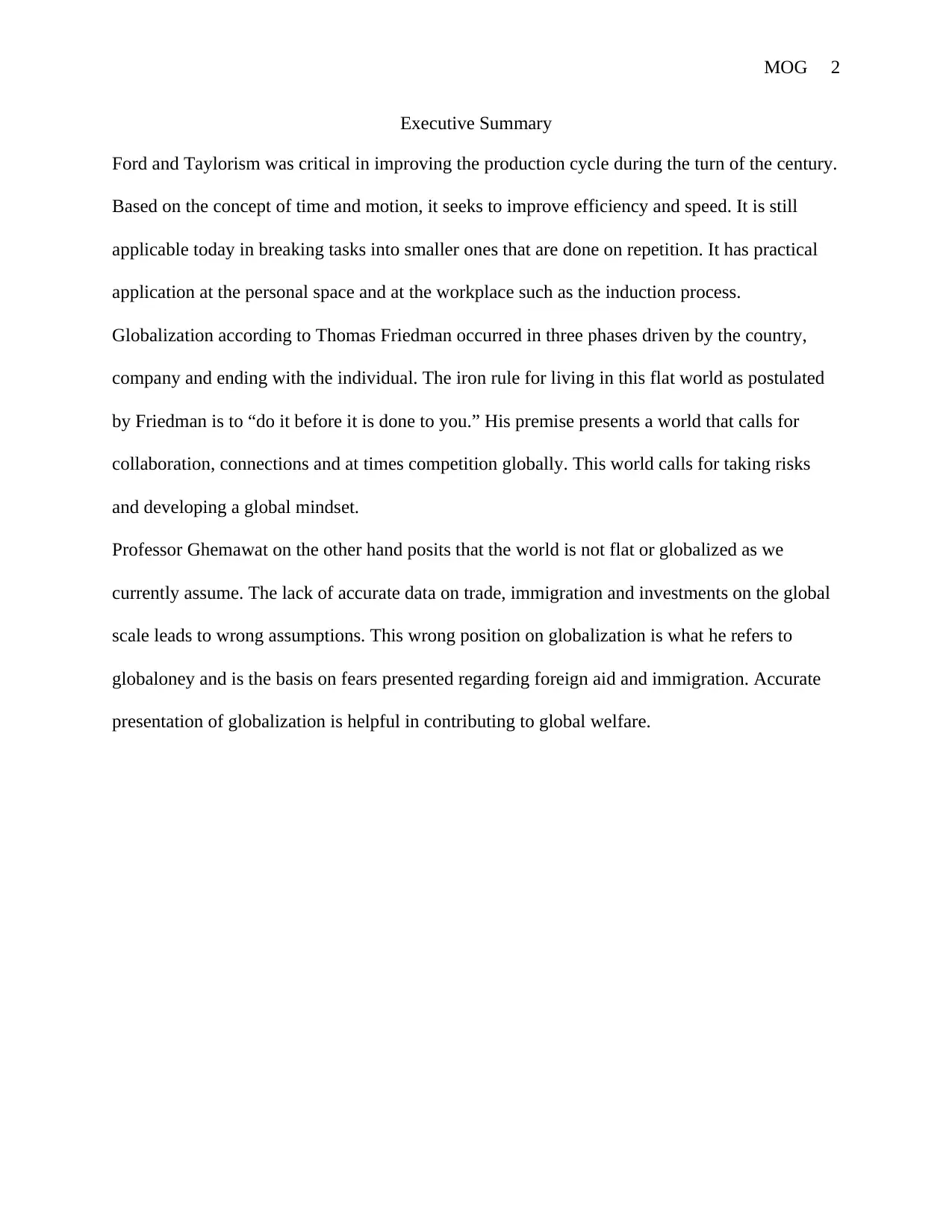
MOG 2
Executive Summary
Ford and Taylorism was critical in improving the production cycle during the turn of the century.
Based on the concept of time and motion, it seeks to improve efficiency and speed. It is still
applicable today in breaking tasks into smaller ones that are done on repetition. It has practical
application at the personal space and at the workplace such as the induction process.
Globalization according to Thomas Friedman occurred in three phases driven by the country,
company and ending with the individual. The iron rule for living in this flat world as postulated
by Friedman is to “do it before it is done to you.” His premise presents a world that calls for
collaboration, connections and at times competition globally. This world calls for taking risks
and developing a global mindset.
Professor Ghemawat on the other hand posits that the world is not flat or globalized as we
currently assume. The lack of accurate data on trade, immigration and investments on the global
scale leads to wrong assumptions. This wrong position on globalization is what he refers to
globaloney and is the basis on fears presented regarding foreign aid and immigration. Accurate
presentation of globalization is helpful in contributing to global welfare.
Executive Summary
Ford and Taylorism was critical in improving the production cycle during the turn of the century.
Based on the concept of time and motion, it seeks to improve efficiency and speed. It is still
applicable today in breaking tasks into smaller ones that are done on repetition. It has practical
application at the personal space and at the workplace such as the induction process.
Globalization according to Thomas Friedman occurred in three phases driven by the country,
company and ending with the individual. The iron rule for living in this flat world as postulated
by Friedman is to “do it before it is done to you.” His premise presents a world that calls for
collaboration, connections and at times competition globally. This world calls for taking risks
and developing a global mindset.
Professor Ghemawat on the other hand posits that the world is not flat or globalized as we
currently assume. The lack of accurate data on trade, immigration and investments on the global
scale leads to wrong assumptions. This wrong position on globalization is what he refers to
globaloney and is the basis on fears presented regarding foreign aid and immigration. Accurate
presentation of globalization is helpful in contributing to global welfare.
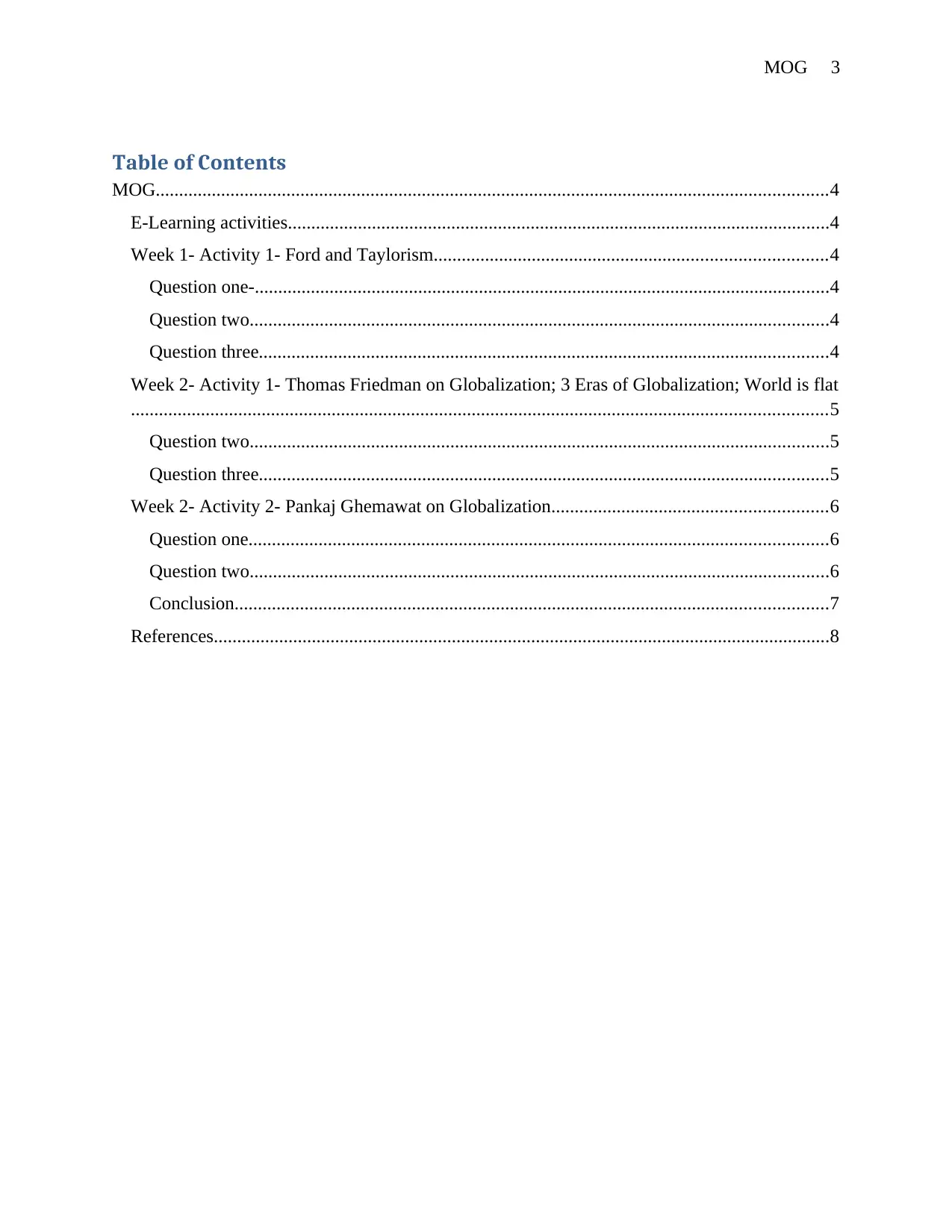
MOG 3
Table of Contents
MOG................................................................................................................................................4
E-Learning activities....................................................................................................................4
Week 1- Activity 1- Ford and Taylorism....................................................................................4
Question one-...........................................................................................................................4
Question two............................................................................................................................4
Question three..........................................................................................................................4
Week 2- Activity 1- Thomas Friedman on Globalization; 3 Eras of Globalization; World is flat
.....................................................................................................................................................5
Question two............................................................................................................................5
Question three..........................................................................................................................5
Week 2- Activity 2- Pankaj Ghemawat on Globalization...........................................................6
Question one............................................................................................................................6
Question two............................................................................................................................6
Conclusion...............................................................................................................................7
References....................................................................................................................................8
Table of Contents
MOG................................................................................................................................................4
E-Learning activities....................................................................................................................4
Week 1- Activity 1- Ford and Taylorism....................................................................................4
Question one-...........................................................................................................................4
Question two............................................................................................................................4
Question three..........................................................................................................................4
Week 2- Activity 1- Thomas Friedman on Globalization; 3 Eras of Globalization; World is flat
.....................................................................................................................................................5
Question two............................................................................................................................5
Question three..........................................................................................................................5
Week 2- Activity 2- Pankaj Ghemawat on Globalization...........................................................6
Question one............................................................................................................................6
Question two............................................................................................................................6
Conclusion...............................................................................................................................7
References....................................................................................................................................8
⊘ This is a preview!⊘
Do you want full access?
Subscribe today to unlock all pages.

Trusted by 1+ million students worldwide
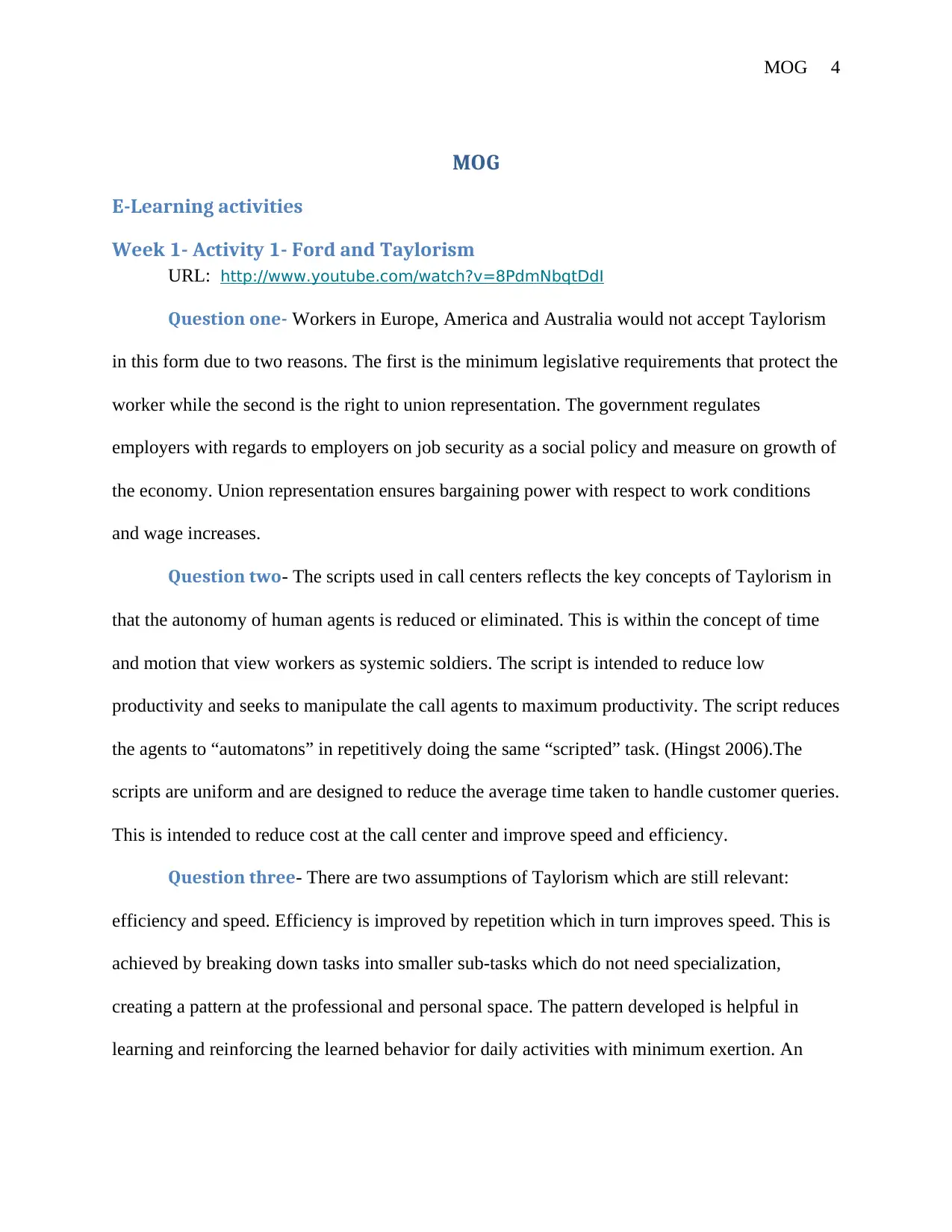
MOG 4
MOG
E-Learning activities
Week 1- Activity 1- Ford and Taylorism
URL: http://www.youtube.com/watch?v=8PdmNbqtDdI
Question one- Workers in Europe, America and Australia would not accept Taylorism
in this form due to two reasons. The first is the minimum legislative requirements that protect the
worker while the second is the right to union representation. The government regulates
employers with regards to employers on job security as a social policy and measure on growth of
the economy. Union representation ensures bargaining power with respect to work conditions
and wage increases.
Question two- The scripts used in call centers reflects the key concepts of Taylorism in
that the autonomy of human agents is reduced or eliminated. This is within the concept of time
and motion that view workers as systemic soldiers. The script is intended to reduce low
productivity and seeks to manipulate the call agents to maximum productivity. The script reduces
the agents to “automatons” in repetitively doing the same “scripted” task. (Hingst 2006).The
scripts are uniform and are designed to reduce the average time taken to handle customer queries.
This is intended to reduce cost at the call center and improve speed and efficiency.
Question three- There are two assumptions of Taylorism which are still relevant:
efficiency and speed. Efficiency is improved by repetition which in turn improves speed. This is
achieved by breaking down tasks into smaller sub-tasks which do not need specialization,
creating a pattern at the professional and personal space. The pattern developed is helpful in
learning and reinforcing the learned behavior for daily activities with minimum exertion. An
MOG
E-Learning activities
Week 1- Activity 1- Ford and Taylorism
URL: http://www.youtube.com/watch?v=8PdmNbqtDdI
Question one- Workers in Europe, America and Australia would not accept Taylorism
in this form due to two reasons. The first is the minimum legislative requirements that protect the
worker while the second is the right to union representation. The government regulates
employers with regards to employers on job security as a social policy and measure on growth of
the economy. Union representation ensures bargaining power with respect to work conditions
and wage increases.
Question two- The scripts used in call centers reflects the key concepts of Taylorism in
that the autonomy of human agents is reduced or eliminated. This is within the concept of time
and motion that view workers as systemic soldiers. The script is intended to reduce low
productivity and seeks to manipulate the call agents to maximum productivity. The script reduces
the agents to “automatons” in repetitively doing the same “scripted” task. (Hingst 2006).The
scripts are uniform and are designed to reduce the average time taken to handle customer queries.
This is intended to reduce cost at the call center and improve speed and efficiency.
Question three- There are two assumptions of Taylorism which are still relevant:
efficiency and speed. Efficiency is improved by repetition which in turn improves speed. This is
achieved by breaking down tasks into smaller sub-tasks which do not need specialization,
creating a pattern at the professional and personal space. The pattern developed is helpful in
learning and reinforcing the learned behavior for daily activities with minimum exertion. An
Paraphrase This Document
Need a fresh take? Get an instant paraphrase of this document with our AI Paraphraser
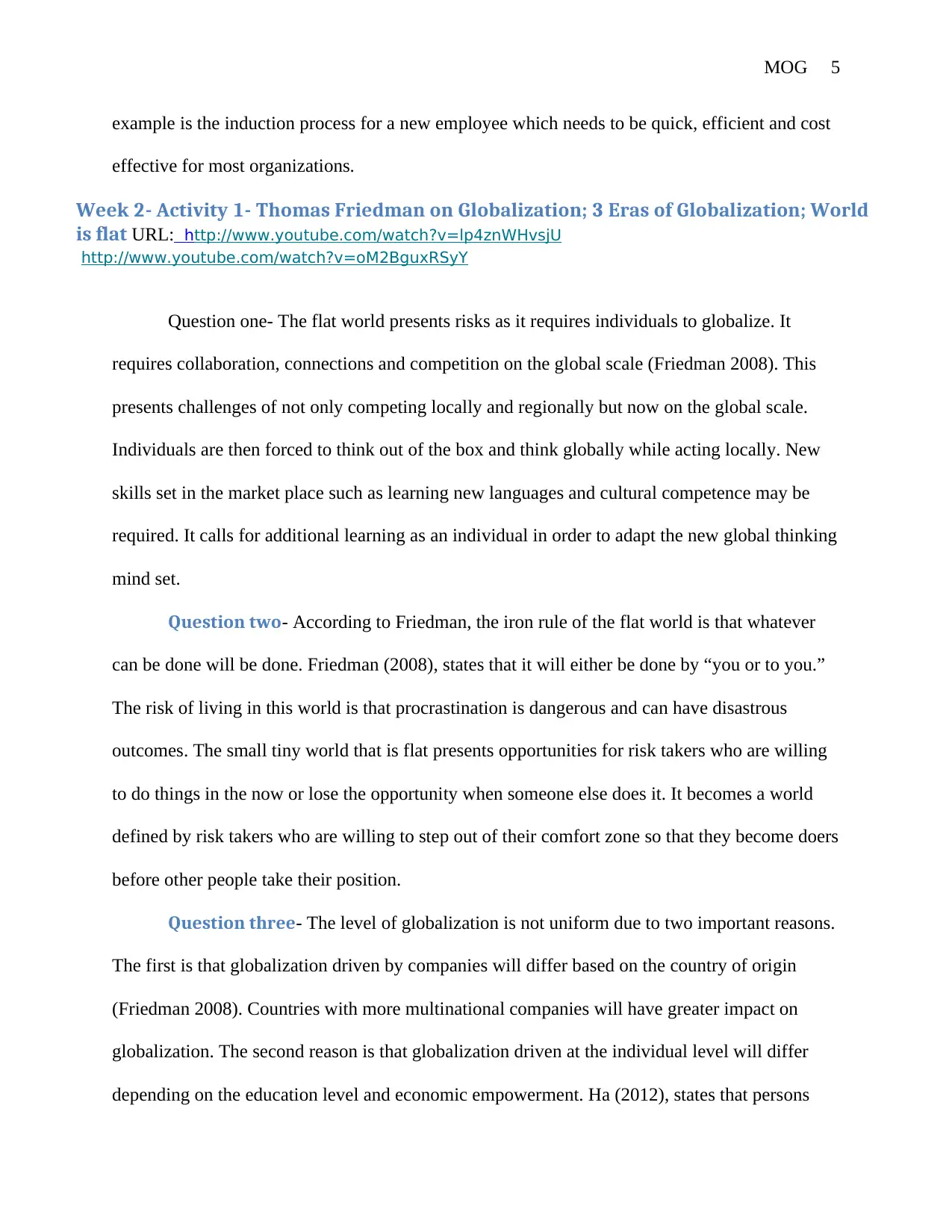
MOG 5
example is the induction process for a new employee which needs to be quick, efficient and cost
effective for most organizations.
Week 2- Activity 1- Thomas Friedman on Globalization; 3 Eras of Globalization; World
is flat URL: http://www.youtube.com/watch?v=lp4znWHvsjU
http://www.youtube.com/watch?v=oM2BguxRSyY
Question one- The flat world presents risks as it requires individuals to globalize. It
requires collaboration, connections and competition on the global scale (Friedman 2008). This
presents challenges of not only competing locally and regionally but now on the global scale.
Individuals are then forced to think out of the box and think globally while acting locally. New
skills set in the market place such as learning new languages and cultural competence may be
required. It calls for additional learning as an individual in order to adapt the new global thinking
mind set.
Question two- According to Friedman, the iron rule of the flat world is that whatever
can be done will be done. Friedman (2008), states that it will either be done by “you or to you.”
The risk of living in this world is that procrastination is dangerous and can have disastrous
outcomes. The small tiny world that is flat presents opportunities for risk takers who are willing
to do things in the now or lose the opportunity when someone else does it. It becomes a world
defined by risk takers who are willing to step out of their comfort zone so that they become doers
before other people take their position.
Question three- The level of globalization is not uniform due to two important reasons.
The first is that globalization driven by companies will differ based on the country of origin
(Friedman 2008). Countries with more multinational companies will have greater impact on
globalization. The second reason is that globalization driven at the individual level will differ
depending on the education level and economic empowerment. Ha (2012), states that persons
example is the induction process for a new employee which needs to be quick, efficient and cost
effective for most organizations.
Week 2- Activity 1- Thomas Friedman on Globalization; 3 Eras of Globalization; World
is flat URL: http://www.youtube.com/watch?v=lp4znWHvsjU
http://www.youtube.com/watch?v=oM2BguxRSyY
Question one- The flat world presents risks as it requires individuals to globalize. It
requires collaboration, connections and competition on the global scale (Friedman 2008). This
presents challenges of not only competing locally and regionally but now on the global scale.
Individuals are then forced to think out of the box and think globally while acting locally. New
skills set in the market place such as learning new languages and cultural competence may be
required. It calls for additional learning as an individual in order to adapt the new global thinking
mind set.
Question two- According to Friedman, the iron rule of the flat world is that whatever
can be done will be done. Friedman (2008), states that it will either be done by “you or to you.”
The risk of living in this world is that procrastination is dangerous and can have disastrous
outcomes. The small tiny world that is flat presents opportunities for risk takers who are willing
to do things in the now or lose the opportunity when someone else does it. It becomes a world
defined by risk takers who are willing to step out of their comfort zone so that they become doers
before other people take their position.
Question three- The level of globalization is not uniform due to two important reasons.
The first is that globalization driven by companies will differ based on the country of origin
(Friedman 2008). Countries with more multinational companies will have greater impact on
globalization. The second reason is that globalization driven at the individual level will differ
depending on the education level and economic empowerment. Ha (2012), states that persons
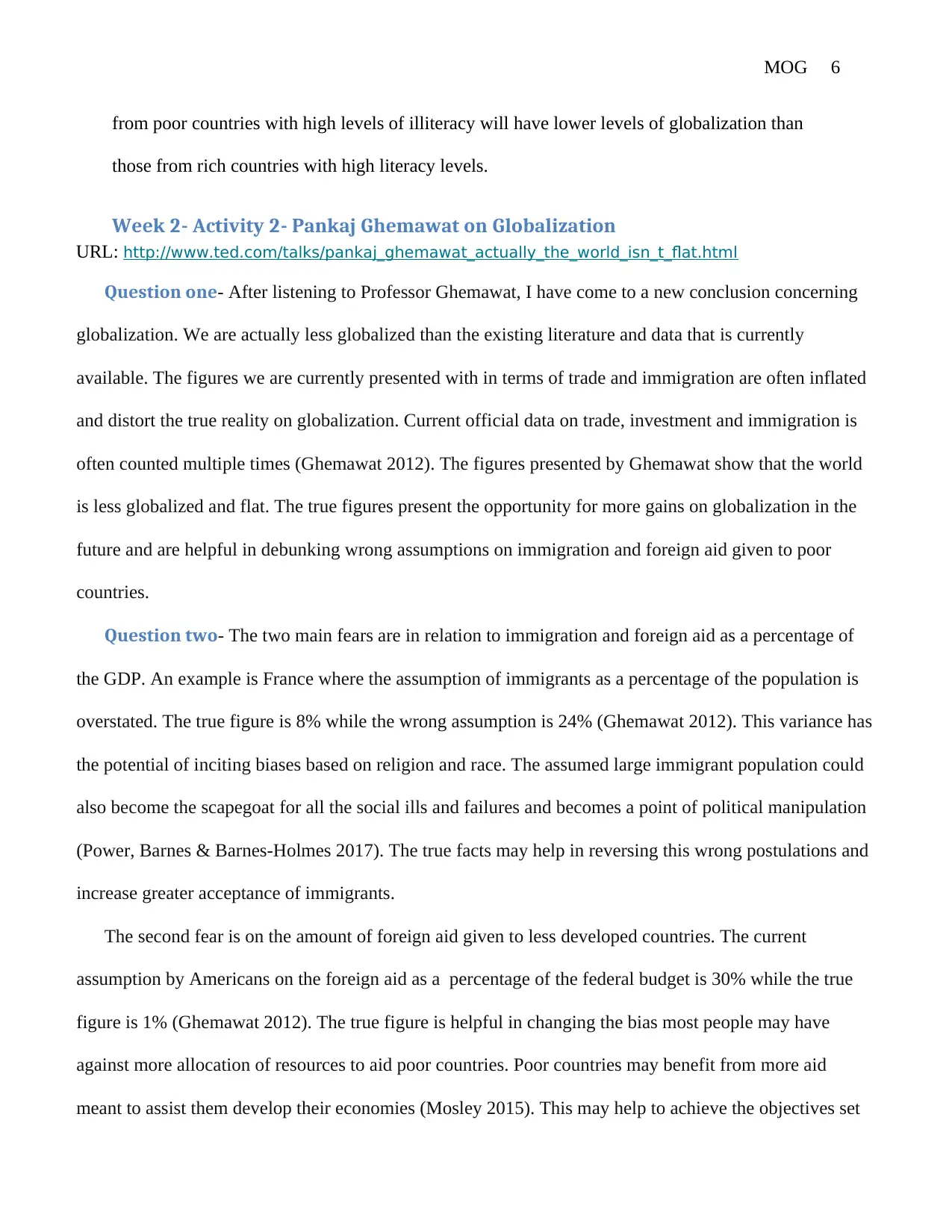
MOG 6
from poor countries with high levels of illiteracy will have lower levels of globalization than
those from rich countries with high literacy levels.
Week 2- Activity 2- Pankaj Ghemawat on Globalization
URL: http://www.ted.com/talks/pankaj_ghemawat_actually_the_world_isn_t_flat.html
Question one- After listening to Professor Ghemawat, I have come to a new conclusion concerning
globalization. We are actually less globalized than the existing literature and data that is currently
available. The figures we are currently presented with in terms of trade and immigration are often inflated
and distort the true reality on globalization. Current official data on trade, investment and immigration is
often counted multiple times (Ghemawat 2012). The figures presented by Ghemawat show that the world
is less globalized and flat. The true figures present the opportunity for more gains on globalization in the
future and are helpful in debunking wrong assumptions on immigration and foreign aid given to poor
countries.
Question two- The two main fears are in relation to immigration and foreign aid as a percentage of
the GDP. An example is France where the assumption of immigrants as a percentage of the population is
overstated. The true figure is 8% while the wrong assumption is 24% (Ghemawat 2012). This variance has
the potential of inciting biases based on religion and race. The assumed large immigrant population could
also become the scapegoat for all the social ills and failures and becomes a point of political manipulation
(Power, Barnes & Barnes-Holmes 2017). The true facts may help in reversing this wrong postulations and
increase greater acceptance of immigrants.
The second fear is on the amount of foreign aid given to less developed countries. The current
assumption by Americans on the foreign aid as a percentage of the federal budget is 30% while the true
figure is 1% (Ghemawat 2012). The true figure is helpful in changing the bias most people may have
against more allocation of resources to aid poor countries. Poor countries may benefit from more aid
meant to assist them develop their economies (Mosley 2015). This may help to achieve the objectives set
from poor countries with high levels of illiteracy will have lower levels of globalization than
those from rich countries with high literacy levels.
Week 2- Activity 2- Pankaj Ghemawat on Globalization
URL: http://www.ted.com/talks/pankaj_ghemawat_actually_the_world_isn_t_flat.html
Question one- After listening to Professor Ghemawat, I have come to a new conclusion concerning
globalization. We are actually less globalized than the existing literature and data that is currently
available. The figures we are currently presented with in terms of trade and immigration are often inflated
and distort the true reality on globalization. Current official data on trade, investment and immigration is
often counted multiple times (Ghemawat 2012). The figures presented by Ghemawat show that the world
is less globalized and flat. The true figures present the opportunity for more gains on globalization in the
future and are helpful in debunking wrong assumptions on immigration and foreign aid given to poor
countries.
Question two- The two main fears are in relation to immigration and foreign aid as a percentage of
the GDP. An example is France where the assumption of immigrants as a percentage of the population is
overstated. The true figure is 8% while the wrong assumption is 24% (Ghemawat 2012). This variance has
the potential of inciting biases based on religion and race. The assumed large immigrant population could
also become the scapegoat for all the social ills and failures and becomes a point of political manipulation
(Power, Barnes & Barnes-Holmes 2017). The true facts may help in reversing this wrong postulations and
increase greater acceptance of immigrants.
The second fear is on the amount of foreign aid given to less developed countries. The current
assumption by Americans on the foreign aid as a percentage of the federal budget is 30% while the true
figure is 1% (Ghemawat 2012). The true figure is helpful in changing the bias most people may have
against more allocation of resources to aid poor countries. Poor countries may benefit from more aid
meant to assist them develop their economies (Mosley 2015). This may help to achieve the objectives set
⊘ This is a preview!⊘
Do you want full access?
Subscribe today to unlock all pages.

Trusted by 1+ million students worldwide
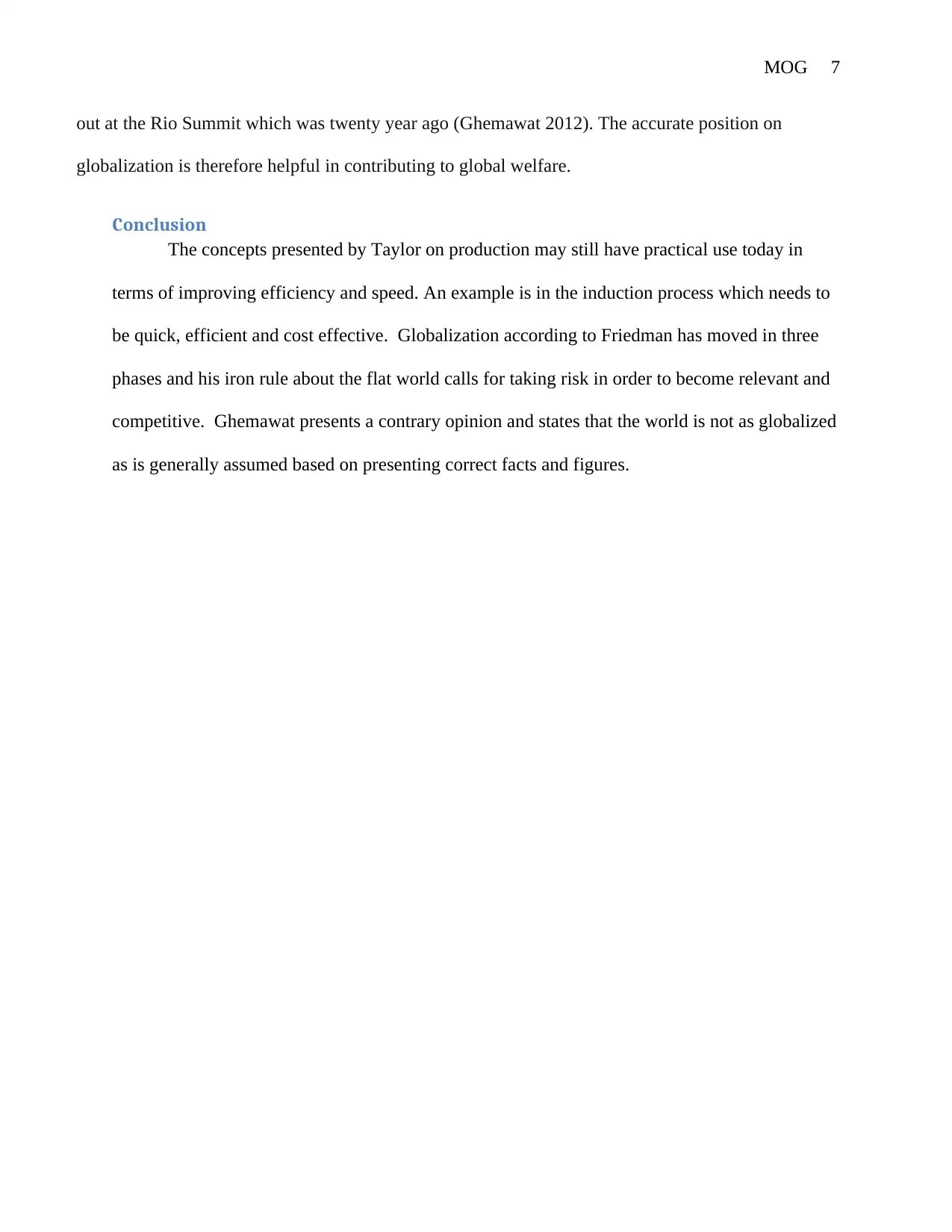
MOG 7
out at the Rio Summit which was twenty year ago (Ghemawat 2012). The accurate position on
globalization is therefore helpful in contributing to global welfare.
Conclusion
The concepts presented by Taylor on production may still have practical use today in
terms of improving efficiency and speed. An example is in the induction process which needs to
be quick, efficient and cost effective. Globalization according to Friedman has moved in three
phases and his iron rule about the flat world calls for taking risk in order to become relevant and
competitive. Ghemawat presents a contrary opinion and states that the world is not as globalized
as is generally assumed based on presenting correct facts and figures.
out at the Rio Summit which was twenty year ago (Ghemawat 2012). The accurate position on
globalization is therefore helpful in contributing to global welfare.
Conclusion
The concepts presented by Taylor on production may still have practical use today in
terms of improving efficiency and speed. An example is in the induction process which needs to
be quick, efficient and cost effective. Globalization according to Friedman has moved in three
phases and his iron rule about the flat world calls for taking risk in order to become relevant and
competitive. Ghemawat presents a contrary opinion and states that the world is not as globalized
as is generally assumed based on presenting correct facts and figures.
Paraphrase This Document
Need a fresh take? Get an instant paraphrase of this document with our AI Paraphraser
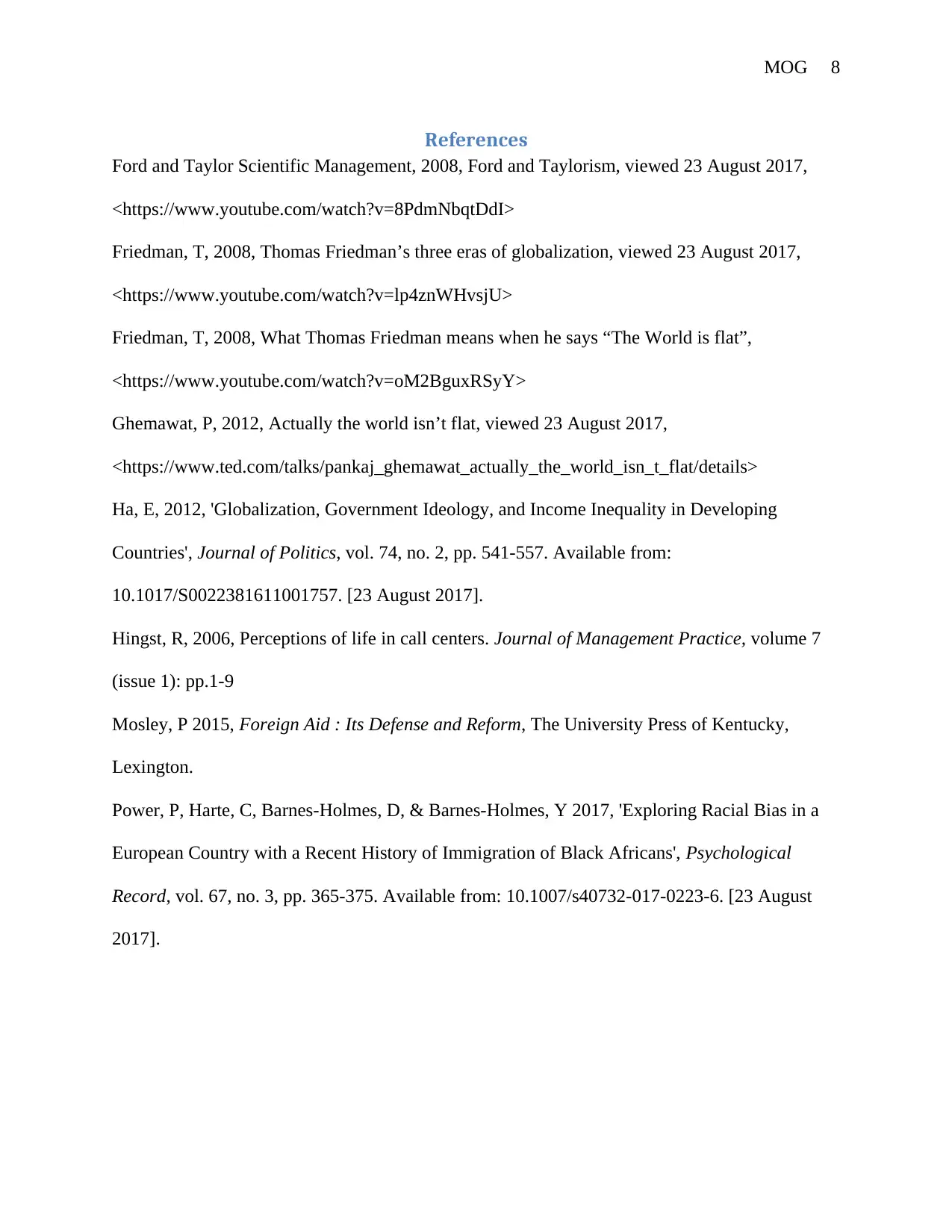
MOG 8
References
Ford and Taylor Scientific Management, 2008, Ford and Taylorism, viewed 23 August 2017,
<https://www.youtube.com/watch?v=8PdmNbqtDdI>
Friedman, T, 2008, Thomas Friedman’s three eras of globalization, viewed 23 August 2017,
<https://www.youtube.com/watch?v=lp4znWHvsjU>
Friedman, T, 2008, What Thomas Friedman means when he says “The World is flat”,
<https://www.youtube.com/watch?v=oM2BguxRSyY>
Ghemawat, P, 2012, Actually the world isn’t flat, viewed 23 August 2017,
<https://www.ted.com/talks/pankaj_ghemawat_actually_the_world_isn_t_flat/details>
Ha, E, 2012, 'Globalization, Government Ideology, and Income Inequality in Developing
Countries', Journal of Politics, vol. 74, no. 2, pp. 541-557. Available from:
10.1017/S0022381611001757. [23 August 2017].
Hingst, R, 2006, Perceptions of life in call centers. Journal of Management Practice, volume 7
(issue 1): pp.1-9
Mosley, P 2015, Foreign Aid : Its Defense and Reform, The University Press of Kentucky,
Lexington.
Power, P, Harte, C, Barnes-Holmes, D, & Barnes-Holmes, Y 2017, 'Exploring Racial Bias in a
European Country with a Recent History of Immigration of Black Africans', Psychological
Record, vol. 67, no. 3, pp. 365-375. Available from: 10.1007/s40732-017-0223-6. [23 August
2017].
References
Ford and Taylor Scientific Management, 2008, Ford and Taylorism, viewed 23 August 2017,
<https://www.youtube.com/watch?v=8PdmNbqtDdI>
Friedman, T, 2008, Thomas Friedman’s three eras of globalization, viewed 23 August 2017,
<https://www.youtube.com/watch?v=lp4znWHvsjU>
Friedman, T, 2008, What Thomas Friedman means when he says “The World is flat”,
<https://www.youtube.com/watch?v=oM2BguxRSyY>
Ghemawat, P, 2012, Actually the world isn’t flat, viewed 23 August 2017,
<https://www.ted.com/talks/pankaj_ghemawat_actually_the_world_isn_t_flat/details>
Ha, E, 2012, 'Globalization, Government Ideology, and Income Inequality in Developing
Countries', Journal of Politics, vol. 74, no. 2, pp. 541-557. Available from:
10.1017/S0022381611001757. [23 August 2017].
Hingst, R, 2006, Perceptions of life in call centers. Journal of Management Practice, volume 7
(issue 1): pp.1-9
Mosley, P 2015, Foreign Aid : Its Defense and Reform, The University Press of Kentucky,
Lexington.
Power, P, Harte, C, Barnes-Holmes, D, & Barnes-Holmes, Y 2017, 'Exploring Racial Bias in a
European Country with a Recent History of Immigration of Black Africans', Psychological
Record, vol. 67, no. 3, pp. 365-375. Available from: 10.1007/s40732-017-0223-6. [23 August
2017].
1 out of 8
Related Documents
Your All-in-One AI-Powered Toolkit for Academic Success.
+13062052269
info@desklib.com
Available 24*7 on WhatsApp / Email
![[object Object]](/_next/static/media/star-bottom.7253800d.svg)
Unlock your academic potential
Copyright © 2020–2025 A2Z Services. All Rights Reserved. Developed and managed by ZUCOL.

